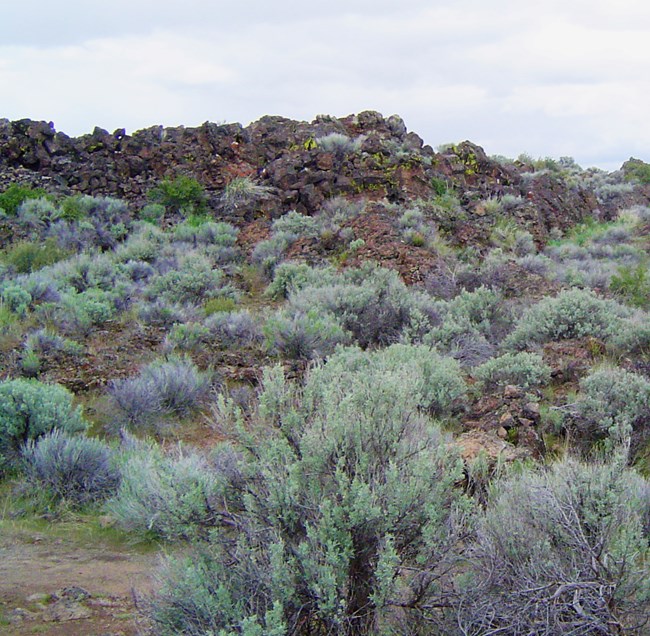Last updated: June 18, 2024
Article
Checking Lava Beds' Vital Signs

NPS/Sonya Daw
Klamath Network Science
National parks are the guardians of our unique American natural and cultural history. But perhaps more than ever before, parks exist in a rapidly changing landscape. Urban growth, replacement of native species by exotics, air and water pollution, increasing visitor use, frequent wildfires, and climate change all impact the natural web of life. This leads us to ask:
How healthy are our parks?
How are they changing?
To answer these questions, the National Park Service created the Inventory and Monitoring Program, which is implemented at 32 networks of parks across the nation. In 2010 at Lava Beds and nearby parks, the Klamath Network began monitoring selected natural resources, called “vital signs,” that serve as indicators of park condition. We visit the same sampling sites over time to track the condition of each of these vital signs in order to help park managers make science-based management decisions.
What Do We Monitor at Lava Beds National Monument?

© Frank D. Lospalluto
Birds
Birds delight us with song and beauty, but also with scientific data! Easily detected, they are good indicators of ecological health because they respond quickly to environmental change. They spread seed and pollen across the land, contributing to the cycle of life. With the Klamath Bird Observatory, we monitor landbird communities in the monument. One common sight is the western meadowlark, whose melodious, piercing song rings out across grassy openings in the monument. Our bird monitoring tracks the distribution and health of park birds and adds to regional landbird projects, like the Avian Knowledge Network Northwest.
During the breeding season, we survey birds to determine
-
the variety of species present
- the relative abundance of each species in the park
Learn more and find recent publications:

NPS/David Hays
Plants and Early Detection of Invasive Species
Perched in the high desert at the edge of the Great Basin, Lava Beds National Monument plant communities range from sagebrush steppe in the lower elevations, to juniper and mountain mahogany woodlands higher up, to pine forests at the highest elevations. One common high desert plant is big sagebrush (Artemisia tridentata). Sagebrush creates islands of fertility and shade in the soil below its branches that help other species establish. Deer, antelope, and jackrabbits depend on sagebrush for winter food and birds use it for cover. But disturbances, like larger and more frequent fires associated with climate change, disproportionately affect species like the big sagebrush that don’t recover quickly after fire. Indeed, much of the monument’s sagebrush cover has been lost to recent fires. To track vegetation community health, we monitor plant abundance and variety. We also track woody debris conditions because heavy debris buildup can fuel hotter, larger, and longer-burning fires.

NPS/David Hays
Tumble mustard (Sisymbrium altissimum) and cheatgrass (Bromus tectorum) are nonnative species— plants that evolved in a different place—that occur in the monument and spread rapidly after fire. Because nonnatives can outcompete native plants, monopolize water, and change the soil, we survey park roads and trails, where nonnatives most commonly occur, to inform possible management action.
Some resources we measure:
-
cover and diversity of native plants
-
cover and diversity of nonnative plants
-
regeneration, by tree seedling counts
-
mortality, by counting dead trees
-
fuel availability, by measuring woody debris and litter and duff depths
- live tree characteristics, like volume (basal area), canopy health, and height
Learn more and find recent publications:
https://www.nps.gov/im/klmn/vegetation.htm
https://www.nps.gov/im/klmn/invasives.htm

NPS/David Hays
Caves
Numerous and diverse lava tube caves lie just below the surface of Lava Beds National Monument. The caves offer a stark contrast to the sunny, high desert conditions above ground. Bears visit to drink from cool cave pool water. Winter brings hibernating Townsend’s big-eared bats (Corynorhinus townsendii). Cold-loving grylloblattids (cricket-like invertebrates) and millipedes roam the cave surfaces. And ferns (in the desert!) grow in the cool, moist climate at cave entrances.

NPS/David Hays
In some caves, air flow patterns supercool the cave rocks to well below freezing close to year-round. Any groundwater present in these areas freezes solid, creating delicate ice structures.
We monitor cave resources and their potential stressors, like human visitation, to help protect this unique ecosystem.
Some resources we measure:
-
cave temperature
-
cave ice surface area and level
-
cave entrance vegetation, including lichen, moss, and ferns
-
hibernating bats during the winter
-
scat and other organic matter
-
cave invertebrates
- amount of human visitation
Learn more and find recent publications:

More Information and Vital Sign Publications
Klamath Inventory and Monitoring Network
Download a printable pdf of this article.
Prepared by Sonya Daw and the Klamath Network staff.
